
Harold Cohen was a pioneer in computer art, in algorithmic art, and in generative art; but as he told me one afternoon in 2010, he was first and foremost a painter. He was also an engineer whose work defined the first generation of computer-generated art. His system, AARON, is one of the longest-running, continually maintained AI systems in history. Harold Cohen was an exceptional artist, an impressive engineer, and an important bridge between those two worlds.
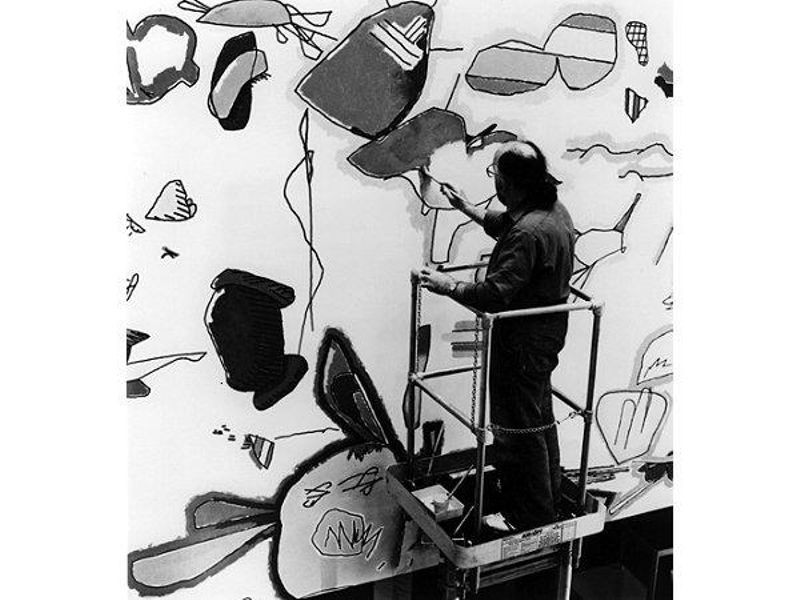
Harold Cohen coloring the forms produced by the AARON drawing “Turtle” at the Computer Museum, Boston, MA, ca. 1982. Collection of the Computer History Museum, 102627459.
Graduating from University of London’s Slade School of Fine Art in 1950, he was a member of the generation of British painters that included David Hockney, Bridget Riley, and Richard Smith. By the early 1960s, he had gained fame with several exhibitions across England, and by the mid-’60s, had begun to show his work internationally, with gallery shows in London, New York, and Toronto. His work focused on abstract, biomorphic forms, with a color palette that seemed to come out of the same pool as the Pop Art practitioners insurgent at the time. His art represented Great Britain in major events such as the Venice Biennale and the Biennale de Paris, two of Europe’s most prestigious art festivals. By the late 1960s, Cohen had grown tired of the London art scene and started to shift his thinking to the topics that would inform the rest of his artistic career—How do artists process their information in the creation of artworks? What are the minimum conditions under which a set of marks functions as an image? What makes an image evocative? To answer these questions, he began investigating children’s drawings and ancient petroglyphs, looking for their “artness.”
In the late 1960s, Cohen became interested in computer technology. He left his home in London for an appointment at the art department at the University of California, San Diego. There, he met Jef Raskin, a graduate student, who introduced Cohen to the college’s CDC 3200 mainframe. Cohen was taken by the possibilities of the computer in determining how artists process their information, since computers are excellent at processing and do so purely based on defined input. Raskin introduced Cohen to programming, starting with FORTRAN. The CDC 3200 at UC San Diego was a batch process machine. A programmer would create a program on punched cards, then submit the cards to be fed into the machine by an operator, who would then return the results, either as a printout or as a series of newly punched cards. Cohen felt stifled by this process and eventually gained access to computers that he could program and run himself. His first computer was a Data General Nova. Later, Cohen acquired Digital Equipment Corp. PDP-11s and VAXs. He started out programming in FORTRAN, before transitioning to the C programming language.
Cohen became a permanent professor at UC San Diego and began delving further into computers. By 1971, he had developed a painting system and presented a paper on it at the Fall Joint Computer Conference. Shortly thereafter, he was invited to display the system and some of its works at the Los Angeles County Museum.

Detail from an untitled AARON drawing, ca. 1980.
These early presentations and papers attracted attention in both art and technology circles, and Cohen was invited as a Visiting Scholar to Stanford’s Artificial Intelligence Lab (SAIL), where he spent two years working on a paint system surrounded by AI luminaries such as John McCarthy and Ed Feigenbaum.
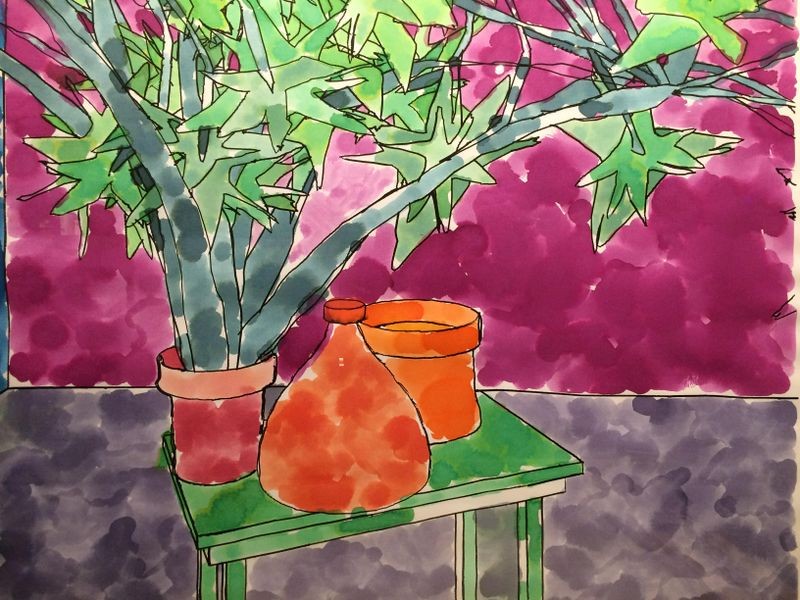
AARON image created at the Computer Museum, Boston, MA, 1995.
Cohen’s initial program was rather simple. He defined a small set of rules and forms that the computer composed into drawings, which were then put to paper using a drawing “turtle”—a small robot equipped with a marker.
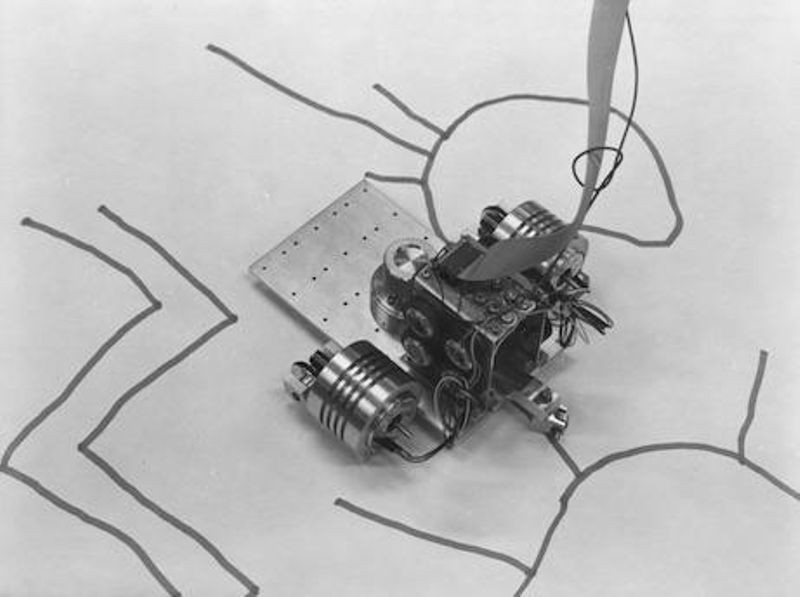
The 1979 exhibition, Drawings, at SFMOMA, featured this “turtle” robot creating drawings in the gallery. Collection of the Computer History Museum, 102627449.
Of the early versions of AARON, Cohen wrote, “In all its versions prior to 1980, AARON dealt exclusively with internal aspects of human cognition. It was intended to identify the functional primitives and differentiations used in the building of mental images and, consequently, in the making of drawings and paintings. The program was able to differentiate, for example, between figure and ground and inside and outside, and to function in terms of similarity, division and repetition. Without any object-specific knowledge of the external world, AARON constituted a severely limited model of human cognition, yet the few primitives it embodied proved to be remarkably powerful in generating highly evocative images: images, that is, that suggested, without describing, an external world.”1
AARON, as Cohen worked with it from 1973 onward, could be seen as an art creation expert system, though Cohen somewhat rejected that moniker.
“… perhaps AARON would be better described as an expert’s system than as an expert system: not simply because I have served as both knowledge engineer and as resident expert, but because the program serves as a research tool for the expansion of my own expert knowledge rather than to encapsulate that knowledge for the use of others,”2 Cohen wrote in 1988.
Video: Harold Cohen’s lecture on Computer Generated Art, September 23, 1980
The initial output of the paint system was primitive; the drawings were black and white, though over time Cohen would color many by hand. Using this technique, AARON produced thousands of drawings at many different scales, from letter-sized paper to massive murals like “Primavera in the Spring,” created for the Computer Museum in 1980.
Cohen dedicated most of his time to creating AARON and less to painting in the 1970s. In 1979, the San Francisco Museum of Modern Art (SFMOMA) held an exhibition called Drawings that featured Cohen’s work. The exhibition featured a hundred-foot long mural of forms drawn by AARON and hand-colored by Cohen, as well as a drawing “turtle” creating images on the museum floor. The SFMOMA exhibit was the first in a string of exhibitions at major museums around the world, including Britain’s venerable Tate Gallery in 1983. AARON created many works that Cohen would color. Cohen’s work with AARON represented a unique man-machine collaboration, which became popular with science centers as an area of exploration. Many commissioned artworks, including what some consider AARON’s masterpiece—”Socrates’ Garden,” created for the Buhl Science Center.
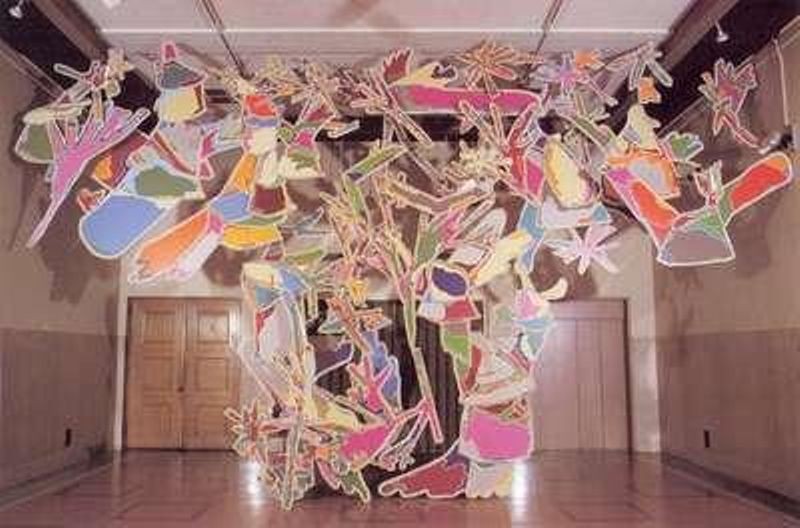
“Socrates’ Garden,” on display at the Buhl Science Center.
Measuring 18 by 23 feet, “Socrates’ Garden” is a series of the biomorphic forms that the early AARON system specialized in creating. Cohen then took the images, enlarged them, colored them with acrylic paint, and mounted the individual forms on plywood, arranging them to form a “tree” that loomed over visitors, immersing them in the piece.
As with any artist, the AARON system went through phases. Those early forms, often resembling children’s drawings, progressed into more biomorphic figures, not dissimilar from those that Cohen himself had specialized in early on in his career. Further innovations during the 1980s saw Cohen increase AARON’s knowledge base, adding more rules and forms, including everyday objects, plants, and even people. At times, Cohen would add forms, such as animals, only to remove those forms when they proved to be inconsistent with Cohen’s own research goals.

The first color image created by AARON at the Computer Museum, Boston, MA, in 1995. Collection of the Computer History Museum. Collection of the Computer History Museum, 102741168.
Harold experimented with several techniques for putting AARON’s drawings to paper. The turtles gave way to sturdier pens on robotic arms. In 1995 Cohen debuted a version of AARON that not only drew the forms, but could color them as well. The system, measuring almost 8 feet long and nearly 6 feet wide, used a vacuum table to hold the paper in place while an arm drew and then colored the forms. This required more complex software, which was only possible with Cohen’s evolution out of the C language into the lingua franca of artificial intelligence—LISP. The Computer Museum in Boston was home to the exhibit, The Robotic Artist: AARON In Living Color. The process was slightly altered for the exhibit. A Silicon Graphics workstation ran AARON’s software overnight, creating many images. Cohen then reviewed the images, selecting one to become the day’s work. Next, the file was loaded onto the PC-compatible, which controlled the robot arm. The robot then mixed paints on a palette to create custom colors, which it applied using a variety of brushes. The images featured fewer of the biomorphic forms that had been the hallmark of the early versions of AARON and, instead, showcased images of people, plants, and tables. The coloring of the drawings was also nearly indistinguishable from that Cohen had done by hand for AARON’s drawings a decade before. Cohen had trained AARON to create convincing “Harold Cohen” paintings.
The exhibit was featured on ABC’s Good Morning America and PBS. The first image created with the new system was sold at an auction held at the Computer Museum in Boston. In 2015, this untitled painting of two figures was donated to the Computer History Museum and is now a part of its Permanent Collection.
Cohen wrote extensively about AARON, looking at the questions a computer-based artistic system raised both within the computing and art worlds. Was AARON creative? Cohen certainly thought that it was not as creative as he had been in creating the program. Who was the artist—Cohen or AARON? Cohen compared it to the relationship between Renaissance painters and their studio assistants. Was the fact that AARON created art works evidence of computer intelligence? On that, Cohen seemed non-committal, saying that AARON never worked to improve itself, a sure sign of intelligence, but at the same time defending the fact that AARON did just what human artists did, taking knowledge of forms and applying them to the creation process.
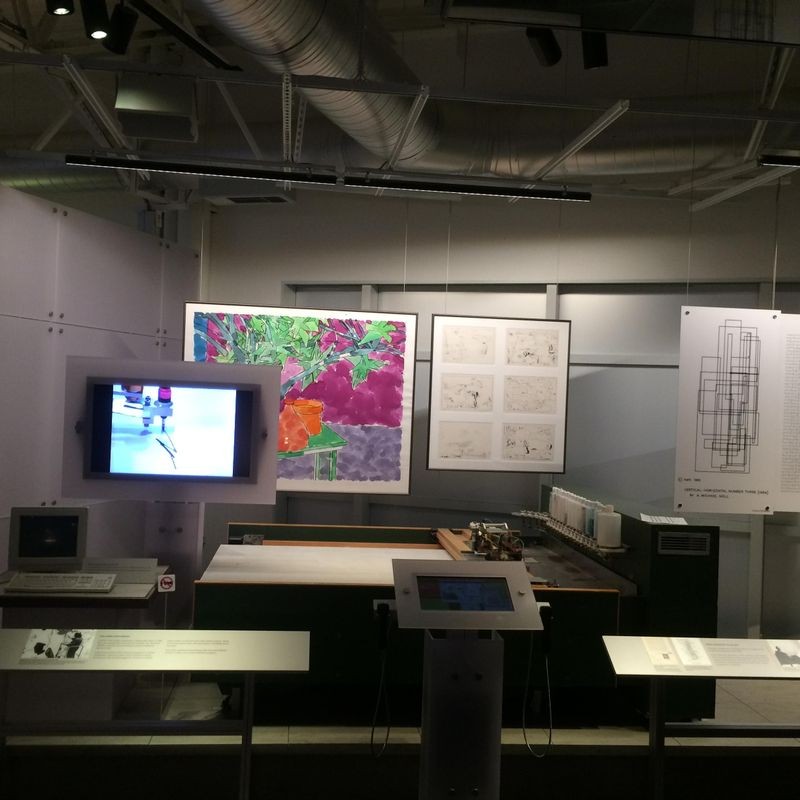
AARON Paint System on display at the Computer History Museum in Revolution: The First 2000 Years of Computing.
Harold came to visit the Computer History Museum in the summer of 2010 to help us re-assemble the 1995 version of AARON for our exhibition, Revolution: The First 2000 Years of Computing. I was lucky enough to spend the afternoon assisting him, amicably chatting about art, film, and his work. I asked him why he had not created a process by which AARON would sign its paintings. “Well,” he said, “I guess if it ever signed a painting on its own, that would signal the end of all debate on the matter of its intelligence.”
I later discovered a painting in our collection that had been signed “AARON 19-7-85″ in the familiar style of the system. Apparently, this had been a short-lived experiment.
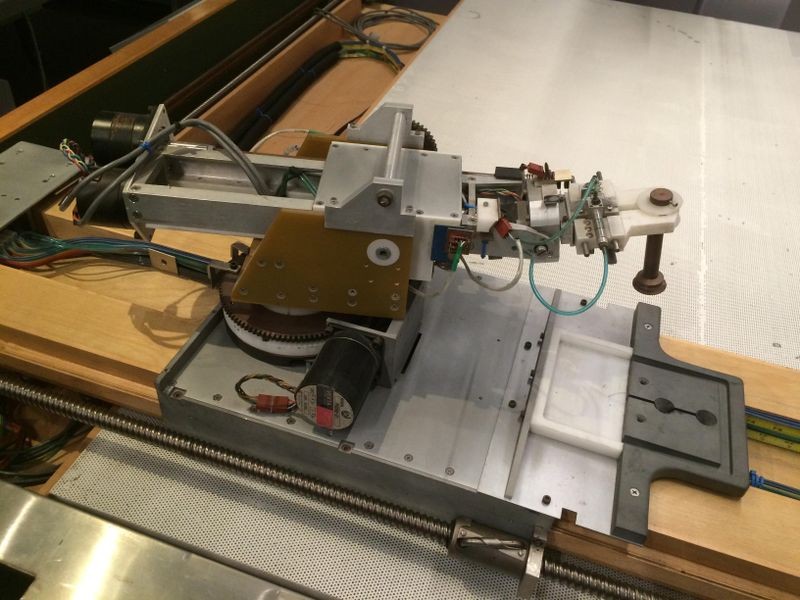
The 1995 version of AARON could color its own images using a variety of brushes and a robotic arm.
Cohen continued to create works and write well into his 80s. On February 8, 2016, Cohen published Fingerpainting for the 21st Century. In it, he describes the latest iteration of AARON. Much like the system displayed at the Computer Museum in 1995, a Linux-based workstation generates line drawings akin to those AARON created in its earliest form. Cohen would then select images to send to a Windows machine attached to two monitors: one displaying a paint system control screen, and the other a 7-foot-tall display showing the artwork. Selecting a brush type and color from the palette on the control screen, Cohen could then color the work using his fingers on the large screen. Cohen described how his relationship with AARON had changed with this version.
“It never occurred to me until recently that I had changed the terms of my relationship with my program, my collaborator, in a very fundamental way. Before this new phase, it had always been necessary to bring AARON’s contribution out of the program’s space so that I could make my own physical contribution—that is, printing its drawings on canvas before I could start the coloring. Now I am working almost entirely in the program’s space. Issues of physicality don’t arise until the physical limitations of the hardware make that final stage of adjusting color relationships necessary.”
Harold Cohen passed away on April 27, 2016. He was 87. Over a career that spanned more than 60 years, he exhibited work around the world in dozens of exhibitions. His works are held in major museums like the Victoria & Albert Museum in London, the Stedelijk Museum in Amsterdam, and the Tate Gallery. Commenting on Cohen’s passing, legendary early computer artist Frieder Nake said, “Harold was the lonesome rock of rule-based algorithmic art. Nobody in the world did anything in fine art as courageous, as daring, and as successful as he. His approach was unique in all its facets. His rich work stands out unparalleled.”